Memory Performance: 16GB DDR3-1333 to DDR3-2400 on Ivy Bridge IGP with G.Skill
by Ian Cutress on October 18, 2012 12:00 PM EST- Posted in
- Memory
- G.Skill
- Ivy Bridge
- DDR3
Conversion – Xilisoft 7
Another classic example of memory bandwidth and speed is during video conversion. Data is passed between the memory and the CPU for processing – ideally faster memory here helps as well as memory that can deal with consecutive reads. Multiple threads on the CPU will also provide an additional stress, as each will ask for different data from the system. Our test uses two sets of conversions: first, a series of 160 videos have the first three minutes of each converted from various formats (480p to 1080p mkv) to AAC audio; and second is the motherboard testing, converting 32 1080p videos to iPod format. Each test is measured by the time taken to complete.
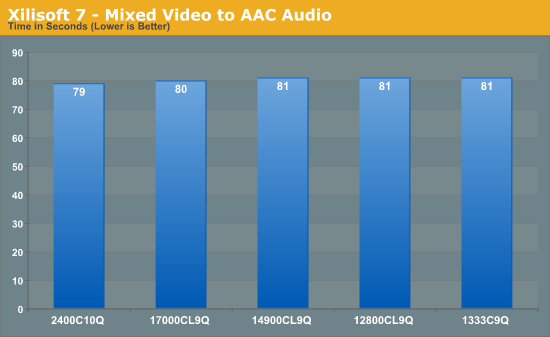
Converting to AAC seems to depend not on the memory – the movement of data from storage to memory to CPU is faster than the CPU can compute.
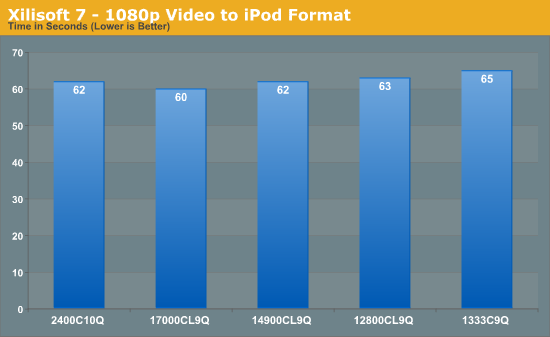
Video conversion is often one area quoted as being beneficial for memory speed, however these does not seem strictly true. As data is moved from storage to memory to the CPU, only if that memory transfer is the limiting factor does having faster memory help. In conversion to an iPod video format, that seems true moving from DDR3-1333 to DDR3-2133 just about, however it seems the limiting factor is still the CPU speed or the algorithm doing the conversion.
Folding on GPU
Memory usage is all algorithm dependent – if the calculation has a lot of small loops that do not require additional reads memory, then memory is unimportant. If the calculation requires data from other sources in those calculations, then memory can either be stressed randomly or sequentially. Using Ryan’s Folding benchmark as a platform, we are testing how much memory affects the serial calculation part of a standard F@H work unit.
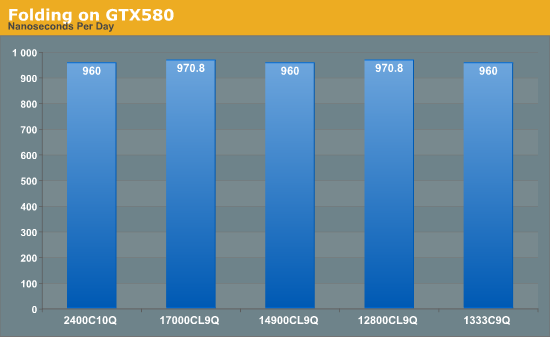
Unfortunately this test is only available to the nearest second, thus the benchmark finishes in either 89 or 90 seconds, giving appropriate ns/day. From the results, folding on GPUs is not affected by memory speed.
WinRAR x64 4.20
When compressing or converting files from one format to another, the file itself is often held in memory then passed through the CPU to be processed, then written back. If the file is larger than the available memory, then there is also loading time between the storage and the memory to consider. WinRAR is a variable multi-threaded benchmark, whereby the files it converts and compresses determines how much multi-threading takes place. When in multithreaded mode, the rate of cache misses can increase, leading to a less-than optimal scaling. Having fast memory can help with this.
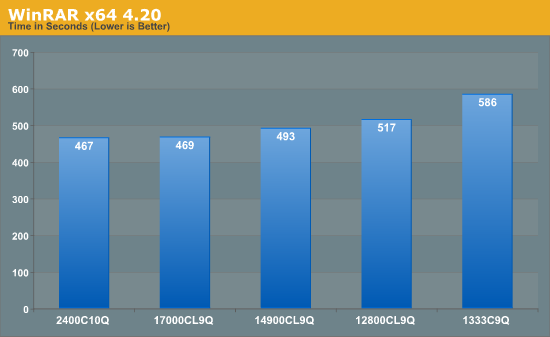
WinRAR is one of the benchmarks in our testing suite that benefits immensely from having faster memory. Moving from DDR3-1333 to DDR3-2400 speeds the process up by 20%, with the biggest gain moving from 1333 to 1600, and noticeable gains all the way up to 2133 C9.
Greysky's x264 HD 5.0.1
The x264 HD test, now version 5.0.1, tests the time to encode a 1080p video file into a high quality x264 video file. This test is standard across a range of reviews from AnandTech and other websites allowing for easy comparison. The benchmark is capable of running all cores to the maximum. Results here are reported as the average across four attempts for both the first and second passes.
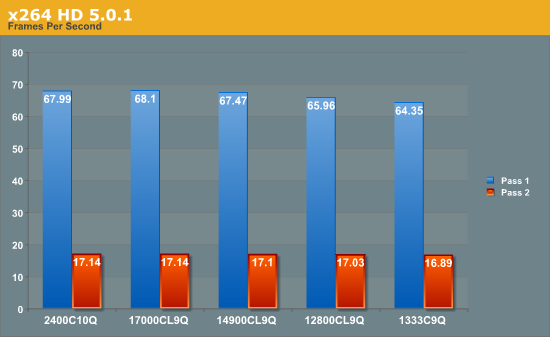
In another conversion test, we see that this benchmark gets a ~5% boost with faster memory, although Pass 1 sees a bigger boost than Pass 2. If conversion into x264 is the main purpose of the system, then the price premium of the faster memory could easily be justifiable.










114 Comments
View All Comments
andrewaggb - Friday, October 19, 2012 - link
Fair enough :-)HisDivineOrder - Thursday, October 18, 2012 - link
You "remember" getting your first memory kit and it was for a E6400. You act like that's just this classic thing.I remember getting a memory kit for my Celeron 300a. I remember getting a memory kit for my AMD K6 with 3dNow!.
Wow, I'm old.
silverblue - Thursday, October 18, 2012 - link
I remember getting a 64MB PC100 DIMM in 2000... it was pretty much £1 a MB. Made a difference, so it was *gulp* worth it.StormyParis - Thursday, October 18, 2012 - link
Very interesting read. Thank you.rscoot - Thursday, October 18, 2012 - link
I remember paying upwards of $400 for a pair of matched 2x512MB Kingston HyperX modules with BH-5 chips. Those were the days! 300MHz at 2-2-2-5 1T in dual channel if you could put enough volts through them. Nowadays I don't think memory matters nearly as much as it did back then.superflex - Thursday, October 18, 2012 - link
Your first kit was an E6400?Let me know when you get hair down there.
My first computer was an Apple IIe in 1984, and my first build was an Opteron 170 with 400 MHz 2,2,2,5 DDR.
Magnus101 - Thursday, October 18, 2012 - link
Once again this only confirms that memory speed makes no real world difference.I mean, who in their right mind use the integrated GPU on an expensive i7-system to play metro-2033 with single digit framerate?
The only thing standing out is the Winrar compression, but, how many use winrar for compression?
Yes to decompress files it is very common but I only remember using it 2-3 times in my whole life to compress my own files.
So that isn't important to most users, except for the ones that actually use winrar to compress files.
And I don't get why the x264 encoding seemed like a big deal. The differences were very small.
It's beem the same story all the way back to the late 90;s were tests between sdr memory at 100 and 133 MHz or at different timings showed no differences in real life applications in contrast to synthetics.
But sure, if you are building a new system and choose between, let say 1333 or 1600, then a $5 difference is a no brainer.
Then again, it would make no noticeable difference anyway.
silverblue - Thursday, October 18, 2012 - link
Here's one - will it affect QuickSync in any way?twoodpecker - Monday, October 22, 2012 - link
I'd be interested in QuickSync results too. In my experience, not proven, it makes a big difference. I adjusted my memory speeds from 1600 to 2000 and noticed at some point that encoding is 25x instead of 15x. This might be due to different factors though, like software optimizations, because I didn't benchmark after adjusting mem speeds.Geofram - Thursday, October 18, 2012 - link
I don't believe he's implying that single digit frame rates on a game are going to real-life usable for anyone. I believe the point of the test was simply: "Lets take a system that is generally fast and put it in a situation where the IGP is being stressed. This will be the best-case scenario for faster RAM helping it. Lets see if it does".To me the idea was not showing everyone everyday situations where faster RAM will help them, instead it was to see where those situations might lay, by setting up a stressful situation and seeing the results. Most of the results were extremely small differences.
I agree it's not a noticeable difference in most cases. It doesn't make me feel like I should get rid of PC1333 RAM. I don't fault the logic for the tests used however. It was nice to see someone actually comparing the slight differences caused by RAM speed.